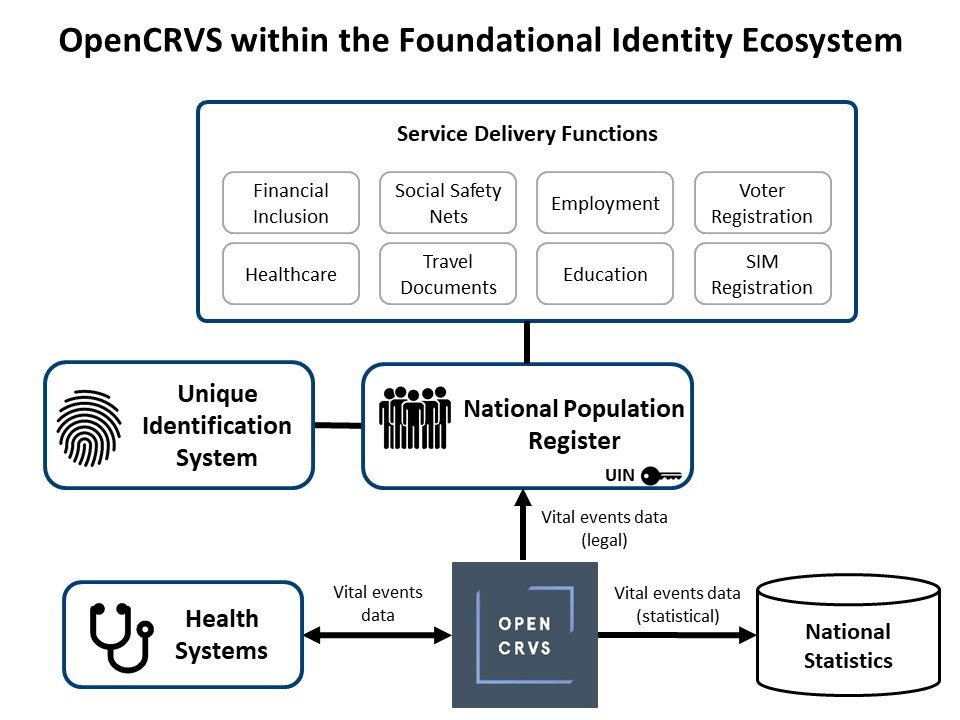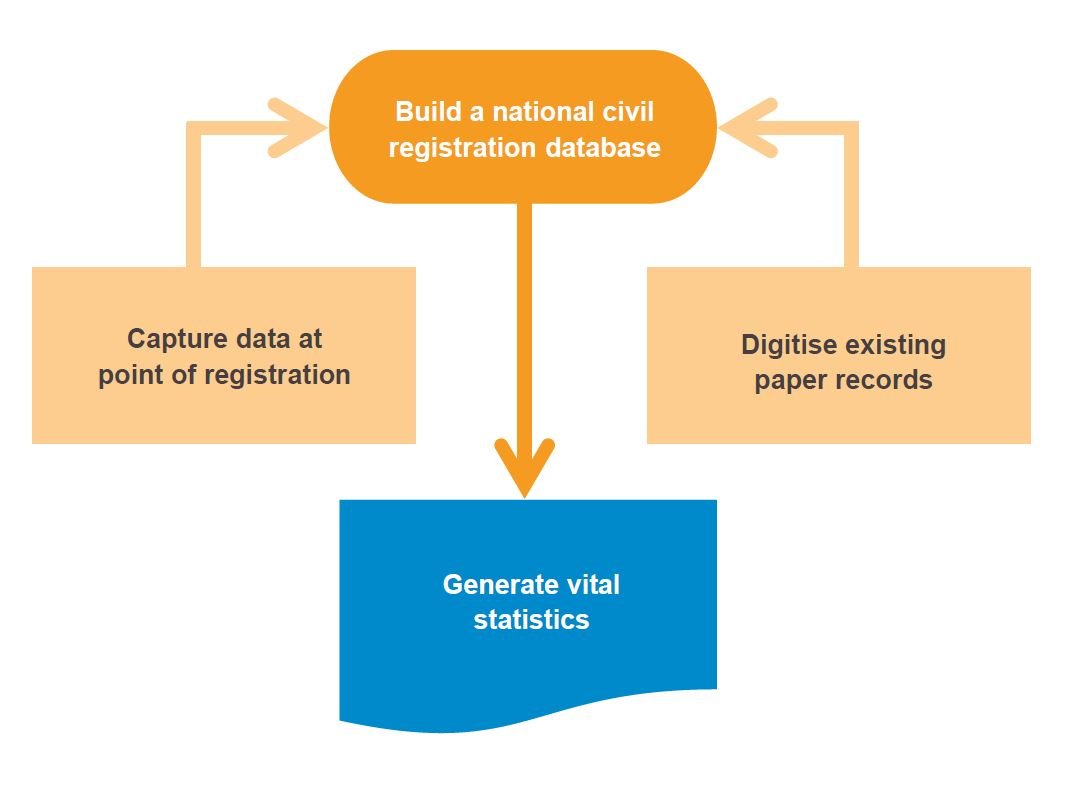Digital civil registration and legal identity systems: A joined-up approach to leave no one behind: Chapter 3
Delivering digital CRVS and legal identity systems
DownloadsProgress so far
In November 2019, the results of a survey that tracked progress across 40 countries were tabled at the Africa Programme on Accelerated Improvement of Civil Registration and Vital Statistics (APAI-CRVS)’s fifth ministerial conference (see Table 1). [1] The results showed that:
- 73% of countries have developed costed plans to improve their systems
- 65% have begun implementing these plans
- 45% have allocated budget for the improvement plans
- 60% have a national civil registration database
- 65% have begun to capture birth and death records electronically at local registry offices. [2]
Much of the survey reflected good intentions rather than achieved results. New systems for the most part do not seamlessly connect registry offices to national databases and are currently not capable of automatically generating vital statistics. There is little interoperability between health systems, and mobile technology is surprisingly under-utilised.
Nevertheless, the underlying trend in some of the world’s most challenged economies is towards digital data capture at the point of registration and the production of vital statistics from national databases that are dynamically fed from local registry offices.
Table 1: Selected results from a survey on the status of CRVS in Africa
|
Responses (%)
(n=40) |
Yes | No | n.r. |
|---|---|---|---|
| Has your country conducted a comprehensive assessment on the national CRVS system? | 78 | 23 | 0 |
| Has your country developed a costed strategic plan to improve CRVS system using the results of the comprehensive assessment? | 73 | 28 | 0 |
| Has the government allocated a budget for the implementation of the CRVS improvement strategic plan? | 45 | 50 | 5 |
| Has your country started implementing CRVS improvement costed strategic plan? | 65 | 28 | 8 |
| Are birth and death records captured electronically at the local civil registration office? | 65 | 35 | 0 |
| Is mobile technology used to notify about the occurrence of birth and death at the community level? | 8 | 90 | 3 |
| Do health facilities notify electronically local registration offices about the occurrence of birth and death? | 18 | 83 | 0 |
| Are civil registration records transmitted electronically from the civil registration office to an agency responsible for compiling vital statistics? | 28 | 73 | 0 |
| Are vital statistics on birth and death compiled from the civil registration system? | 68 | 33 | 0 |
| Does your country publish annual vital statistics reports compiled from civil registration data? | 38 | 18 | 45 |
| Is there a national civil registration database? | 60 | 40 | 0 |
| Can vital statistics tables be compiled automatically from the database? | 35 | 13 | 53 |
| Does your country have a national digitised identification database? | 73 | 28 | 0 |
| Is the national identification database linked to the CRVS system? | 30 | 18 | 53 |
| Do civil registrations and National IDs share a Unique Identification Number? | 20 | 10 | 70 |
| Are the CRVS system and national ID management under the same Ministry? | 63 | 38 | 0 |
Source: APAI-CRVS, 2019. Country update on the status of civil registration and vital statistics system. Paper tabled at the Preparatory Meeting of Experts for the Fifth Conference of African Ministirs Responsible for Civil Registration, Lusaka, October 2019. Available at: http://www.apai-crvs.org
Case Study
Digitising civil registration in Benin
In Benin, most civil registration records are found on decades-old paper forms stored in books that are frequently falling apart or damaged. This can prevent people from accessing public services, despite having their birth registered. Keeping paper documents requires significant labour for government officials compared to digital record-keeping; there is also a higher risk of fraud, as it is difficult to validate birth certificates against records held in municipalities. To address this challenge, the country is currently digitising its civil registration systems. Recently, the municipality of Kandi in northern Benin invested a significant amount of time and municipal budget in fully digitising its civil registration. Historic records have been fully digitised and new records are now recorded directly through software. Consequently, the city has significantly reduced the workload of employees and has improved services for its citizens.
Source: Personal observations by a DI analyst working in Benin.
Digital solutions
Converting CRVS systems from paper to digital format is no trivial task (see Figure 9). The challenge of implementing the technological part of the solution nationally is surpassed by the large volume of historical paper-based records that require digitisation.
Advances in optical character recognition technologies are making the task of scanning historical records easier. These technologies are also enabling the development of solutions such as Plan International’s OpenCRVS, which combines industry-level standards with open source code and inexpensive mobile data capture (see Figure 10).
Figure 10: OpenCRVS as part of CRVS and service delivery systems

Diagram showing Open CRVS within the foundational identity ecosystem: open CRVS is connected to health systems (via vital events data), national statistics (via statistical vital events data) and national population register (via legal vital events data); national population register is further connected to unique identification system and service delivery functions (including financial inclusion, social safety nets, employment, voter registration, healthcare, travel documents, education and SIM registration).
Source: Open CRVS, https://www.opencrvs.org/our-solution (accessed 16 March 2019).
One obstacle to digitising CRVS is a lack of short-term incentive for decision-makers. Taking such an action will not provide a government treasury or donor a three- to five-year return on their investment, nor will it benefit a policymaker seeking equivalent political mileage. The key to securing sustainable investment in CRVS systems is a stronger business case built on the long-term benefits of digital infrastructure. This business case is now starting to happen through a joined-up approach between birth registration and legal identity.
Legal identity
Over the past decade, there has been increasing recognition that for civil registration to have the required impact it needs to be integrated with national identity systems that deliver the link between foundational and functional (passport, banking, health, education, social welfare, etc) identities.
For example, according to a World Bank programme review, “robust CRVS systems linked to identity management (IDM) systems and tailored to local contexts form the foundation of all sectors and pillars of the economy and contribute to the sustainable development goals (SDGs) to end poverty, and ensure prosperity for all.” [3]
However, the World Bank’s Identity for Development Global Dataset [4] reveals that while 51 African countries have some form of national ID, only five require ID below the age of 10 and the vast majority only allow the issuance of an ID number at the age of 16 or 18.
SDG 16.9 aims for “legal identity for all, including birth registration”, but refers to the registration of children at birth as only “the first step in securing their recognition before the law”. [5]
On 4 March 2020, the UN Statistical Commission endorsed a new UN Legal Identity Agenda which, significantly, “builds on the existing methodological framework for civil registration and vital statistics … and expands it to ensure a holistic and interoperable approach between civil registration, vital statistics production and identity management.” [6]
This reframing of legal identity means that interoperability between civil registration and national identity systems can no longer be regarded as the preferable option; it becomes essential.
Case Study
Progress towards digitising CRVS in Nigeria
The National Population Commission (NPopC) in Nigeria is responsible for CRVS and has over 2,300 registrars managing a paper-based system. The National Identity Management Commission (NIMC) is responsible for issuing national identity cards and national identification numbers (NINs) and has digitally registered about 35 million Nigerians.
The NPopC and NIMC have adopted a strategic roadmap that is inextricably linked to the digitisation of all birth and death records. It includes the following aims:
- NPopC to digitise all its current birth (and death) records going back to an agreed starting point.
- NPopC to develop human and technical capacity to register all new births in a digital registry of births and deaths, using digital data capture.
- NPopC and NIMC to work together to link new entries in the registry of births and deaths to the issue of a unique NIN – linked to the parents’ NINs – and therefore to the issue of a paper birth certificate containing the NIN.
- This will require automated interoperability between NPopC’s registry of births and deaths and NIMC’s identity number database.
Downloads
Notes
-
1
The survey was sent to the Economic Commission for Africa’s 54 member countries, of whom 40 replied.Return to source text
-
2
Most of the electronic data capture is still being piloted. Only 18% of countries have coverage in all offices.Return to source text
-
3
The World Bank, 2017. World Strengthening CRVS and national ID: January 29, 2016 to October 27, 2017. Completion Report for the World Bank Group Action Plan for Addressing Data Gaps in Civil Registration and Vital Statistics, 2016–2030. Available at: http://documents.worldbank.org/curated/en/306621510673094647/pdf/AUS16865-revised-public.pdfReturn to source text
-
4
The World Bank Group’s Identification for Development Initiative Data. Available at: https://development-data-hub-s3-public.s3.amazonaws.com/ddhfiles/94586/wb_id4d_dataset_2018_0.xlsxReturn to source text
-
5
United Nations’ SDG indicator metadata repository, https://unstats.un.org/sdgs/metadata/files/Metadata-16-09-01.pdf (accessed 16 March 2020)Return to source text
